Archive for 2024

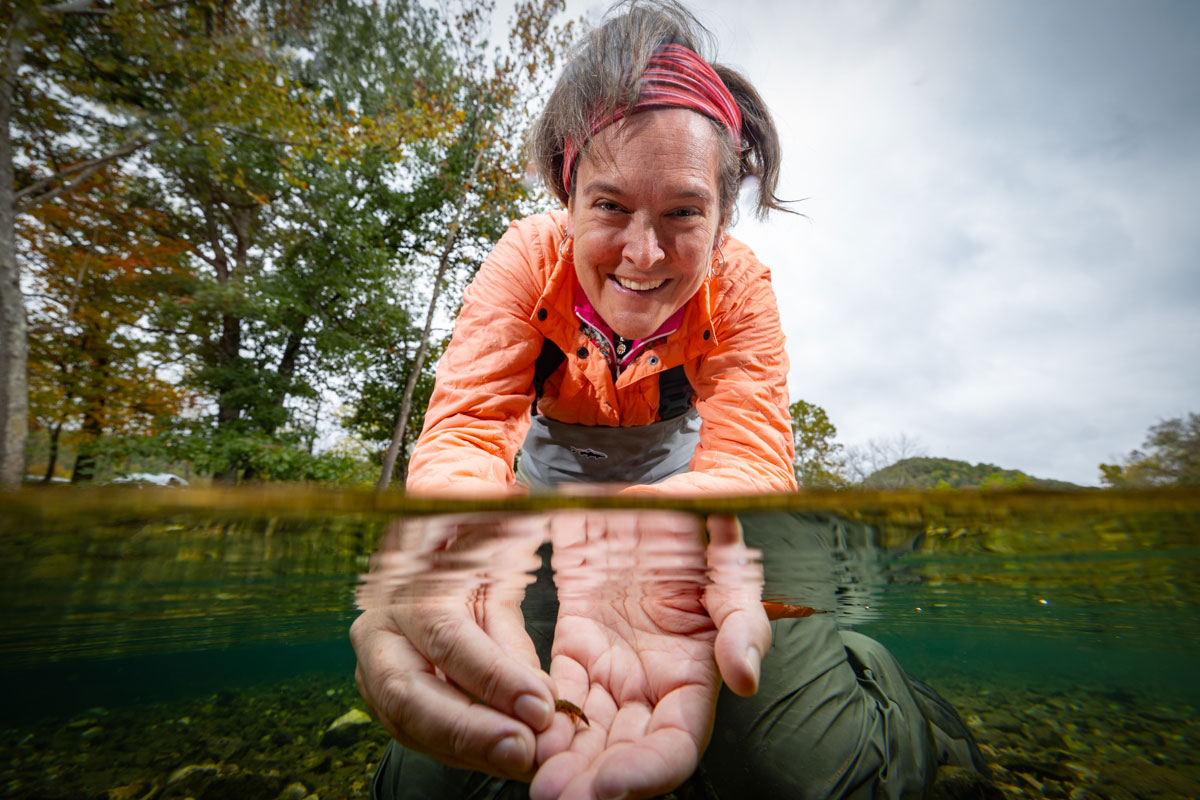
Deciphering the disturbances
Standing in the middle of a running stream, golden sunlight dapples the surface of the water. Gravel underfoot provides a slightly uneven texture. The sound of running water fills the air.
But a disturbance such as a flash flood can turn a shiny stream into a muddy mess of churning gravel in an instant, displacing what lives beneath the waters.
Yet, the streams still flourish.
A love for biology and landscape spatial patterns fuels Dr. Debra Finn’s passion for understanding stream ecology. She has more than 45 publications about streams to her name.
An associate professor of biology at Missouri State University, Finn is driven to understand complexities that lie beneath the water, and how connectivity enables streams to flourish despite disturbances.
Dynamic adaptations
In ecology, a disturbance is any event that can displace or kill organisms living in an area. In streams, one major disturbance is flash floods.
Ozark streams experience flash floods frequently. These have become an obsession for Finn.
“Streams in particular are very dynamic and have a lot of biodiversity,” she said. “But when you go out right after a flood, the stream looks like it’s been decimated. How is it possible that the organisms beneath the water can recover so quickly?”
Natural disturbances are important. If organisms and streams have adaptations to be resilient to the natural disturbances, they might be well positioned to adapt to continued extremes.
“Climate change is causing extremes, like bigger floods and more severe droughts,” Finn said. “Are streams going to be able to withstand that? Can we find ways that they respond to this and can continue to adapt even to all these pressures we’re putting on them?”

Discovering what’s below
In 2017, Nathan Dorff was a student researcher working with Finn. One day in the lab, he curiously peered through a microscope. “Well, I’ve sure never seen anything like this before,” he said.
He pulled out his phone to photograph what he saw through the microscope lens. He sent the photos to several people, hoping someone would recognize the unfamiliar creature. No one did, because — as it turned out — Dorff had just spotted a new species.
Through his microscope, he was looking at a previously unidentified frog-biting midge from an obscure group of flies in the order Diptera.
“It looked like a combination of a mosquito larva and a predaceous fly larva,” he said. “It wasn’t until nearly a year later I began to realize I had indeed discovered something unique.”
Below the streambed, where surface water and ground water mix, is the hyporheic zone. This is where Dorff made his discovery while doing thesis research with Finn on the hyporheic zone’s resilience to flood disturbance.
To collect hyporheic animals as a part of his research for his master of science in biology, he drove wells into the streambed of Bull Creek.
“We dedicated the discovery to the landowners of Bull Mills by naming the new species after them: Corethrella kipferi.”
Dorff’s discovery was published in 2022 in the Journal of Natural History.
Finding a new species alone is momentous. But Dorff’s is especially important as it further highlights the importance of understanding biodiversity nuances, like what’s living beneath the surface of streams, even when there’s no water. 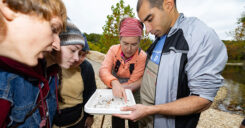
Within the gravels
A dried-up stream leaves a path of gravel to walk on. But to Finn and her students, it’s still a stream. Small invertebrates live within the gravel, waiting for the next rain.
“You can collect a sample of gravel, put it in a bucket with water, and wait a few weeks, you have invertebrates coming out of a state of diapause,” Finn said.
Diapause is a resting stage where creatures stop their metabolism for a while and wait for a cue to continue growing. Here, the cue is water returning to the stream. During a flood, water fills the gaps in the gravel, signaling the invertebrates to continue their life cycle.
“This shows that these dry places that people wouldn’t even recognize as a stream are chock full of aquatic organisms just waiting it out,” Finn said. “To me, that’s clearly a stream.”
The organisms in the gravel grow fast and produce a load of food by “converting those rotting leaves and algae into delicious, yummy protein as fuel for fish and birds,” Finn said. Streams are streams, water or not.
More than a line on a map
Streams are more than skinny bodies of water depicted as a thin blue line on a map. But many don’t realize the importance of the connections streams make to everything around them.
“Streams rely on connectivity between their surface and what’s going on underneath the surface that we can’t see,” Finn said. “They also interact with the land around them, exchanging resources in both directions. Without food resources from the land, you couldn’t have all those fish. And without insects produced from the stream, you would have fewer birds and bats.”
A lack of general understanding leads to human activities that can sever these important connections. Construction projects or dumping sediment into dry streams change everything in terms of the stream’s existence.
There’s space in between the gravel for organisms to crawl around in. But if a big deposit of mucky sediment fills the gaps, it’s suddenly a wall in the water, breaking the connection with the rest of the stream.
“We might be destroying species that will never be discovered.”
Further reading
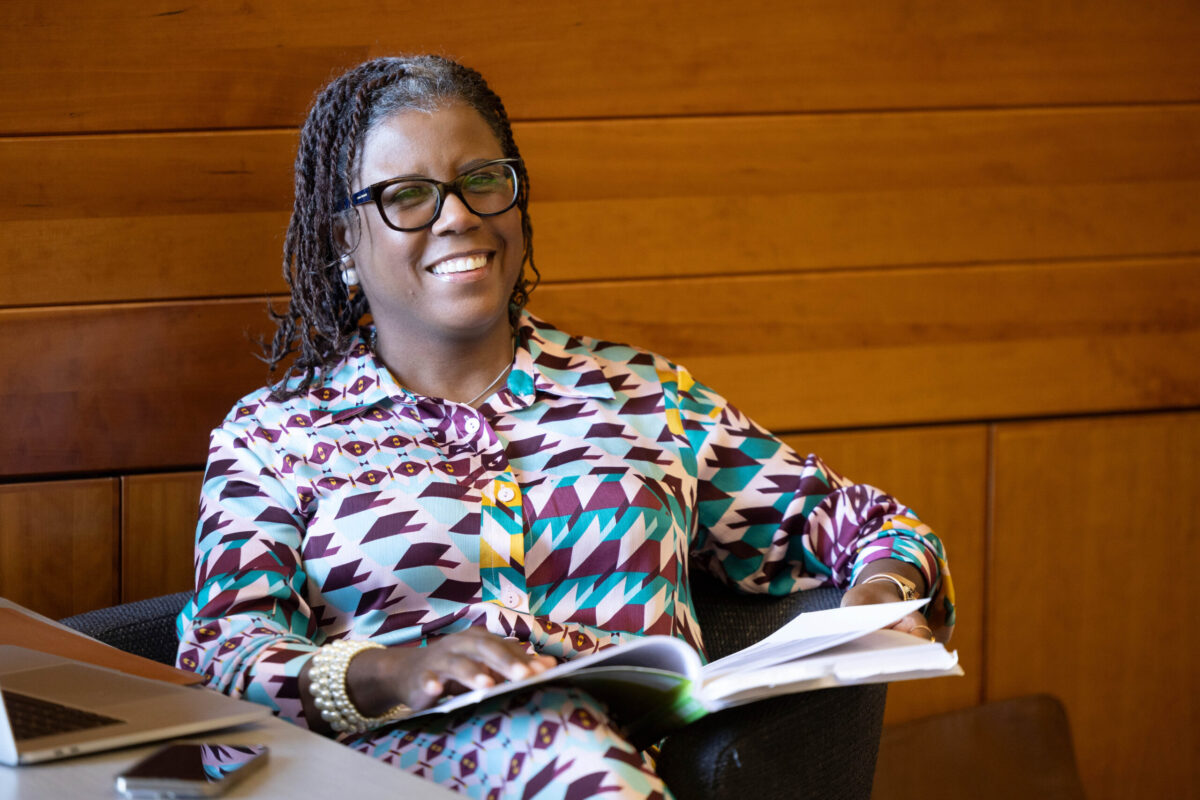
Creating safe spaces to retain women in academia
According to the National Center for Education Statistics, in fall 2020, Black women comprised less than 5% of faculty, 10% of student affairs administrators and 9% of students at degree-granting institutions in the U.S.
Associate professor and assistant director for the School of Special Education, Leadership, and Professional Studies, Dr. Nicole West is one of only seven tenured Black women professors at Missouri State University.
A job shift (from a university administrator to faculty) left West searching for a new community of colleagues. She was inspired to keep studying and creating safe spaces for women on college campuses, a term she coined as “professional counterspaces.”
A cross between a professional development program and a support group, professional counterspaces benefit marginalized individuals, like Black women in higher education, academically, professionally and personally.

Dr. Nicole West provides personal, professional and academic support for women and marginalized individuals in higher education. Kevin White/Missouri State University
The start of it all
Born in Massachusetts and then living most of her young life in Florida, West was used to being one of a few Black female students in her classes.
“It made getting through a doctoral program feel 10 times more difficult,” West said.
It was an unfortunately consistent theme but led her to seek out and appreciate professional counterspaces.
West’s dissertation — where her research started — was about the African American Women’s Summit (AAWS), a program she had attended for years.
West knew how the Summit had impacted her, both as a doctoral student and as a student affairs professional; however, there was no research about professional development programs created by and for Black women in higher education.
This was the tip of the iceberg for West’s research. She has since published five research articles discussing how professional counterspaces, like the AAWS, uplift Black women in higher education.
West expanded her research by developing her own professional counterspaces. In fall 2020, she created a group for Black women students, faculty, staff and administrators at Missouri State called Participatory Action Research Counterspace (PARC).
Consisting of 11 Black women, PARC members spent a year investigating the experiences of Black women on campus. Their investigation led to the Unlikely Allies Conference on campus, held in March 2022. It promoted racial allyship dialogue as a transformative strategy for institutional change.
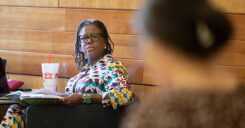
Dr. West meets with her Wednesday Faculty Writing group in the Meyer Library on November 29, 2023. Kevin White/Missouri State University
Practicing action-oriented research
In traditional research models, there’s a divide between the researcher and the participants. West’s model for research differs because it uses co-participants. This levels the power dynamic, so everyone involved co-creates the research together.
“It would be fine to do this research just for the sake of expanding knowledge, but I’m most excited about seeing the tangible outcomes from the research,” West said. “I want to make a difference.”
Fellow PARC member Dr. Azaria Baggett, assistant professor of theatre and dance at Missouri State, said, “actively finding community and taking action to improve the larger community is what makes the PARC so effective. It’s the action piece.”
West and the PARC co-researchers analyzed data from individual interviews, 10 focus groups meetings among the 11 members and a photovoice activity to explain the impact of participating in the PARC.
The photos reflected their experiences as Black women at a predominantly white institution. They were included in an article published in the International Journal of Qualitative Studies in Education.
In fall 2020, West developed another professional counterspace for women faculty at Missouri State, the Wednesday Writing Circle. The goal is to encourage scholarly productivity and a stronger sense of community.
Dr. Marjorie Shavers, director for the School of Special Education, Leadership and Professional Studies, participates in the Wednesday Writing Circle.
“She’s a trailblazer who’s profoundly impacted how we understand and address issues faced by Black women,” Shavers said. “West actively fosters a sense of belonging within the academic community, making her a true asset to her department and the broader university. Her multifaceted contributions continue to shape and inspire positive change.”

Improving the lives of all women in academia through counterspaces
According to West, a lot of the existing research discusses the challenges Black women face, but doesn’t go any further.
She realized Black women take it upon themselves to create strategies to address some of these issues. This is where her idea of professional counterspaces emerged.
“One of the reasons I focus on Black women is because of the concept of intersectionality — which means Black women have multiple marginalized identities. If we create spaces to meet their unique needs, then we’re creating a supportive environment for others with all different types of identity backgrounds.”
Using research to retain students and develop critical thinking
West’s passion for research is contagious among her students. West hopes they will understand that research is something to lean into and not something to shy away from.
Student co-creators gain invaluable, highly transferable skills.
“Developing critical thinking skills will carry students far no matter where they end up professionally,” West said.
More than one student in the PARC mentioned they were ready to leave school after their first semester. But the community of caring and supportive Black women they met during the PARC helped them decide to stay.
“We talk about these outcomes in abstract terms. But there are actual students who have real reservations about staying and students who didn’t do well but leveraged their connections through our group to become more successful,” West said.
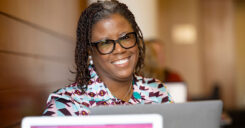
Rising tides raise all ships
The main goal of West’s professional counterspaces is to enhance academic achievement, personal wellbeing and professional success among Black women. And she believes creating safe spaces where Black women in academia thrive makes our classrooms and institutions better for everyone.
West’s research has implications beyond higher education. She believes creating a better experience for Black women inspires their persistence. This is cyclical. Their persistence inspires the ability to recruit and retain more individuals.
“To me, it’s the right thing to do,” West said. “One thing I talk about often is this idea that rising tides raise all ships. If we can save the most marginalized, then we create better conditions for everyone involved.”



